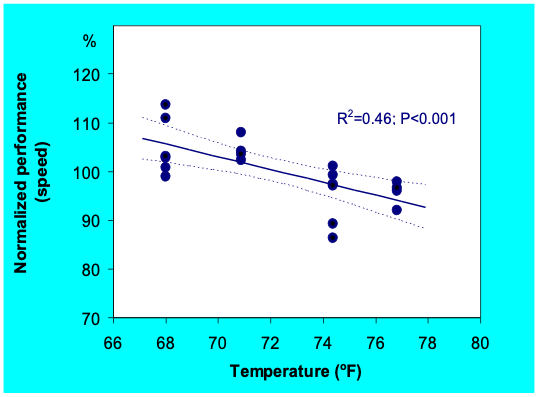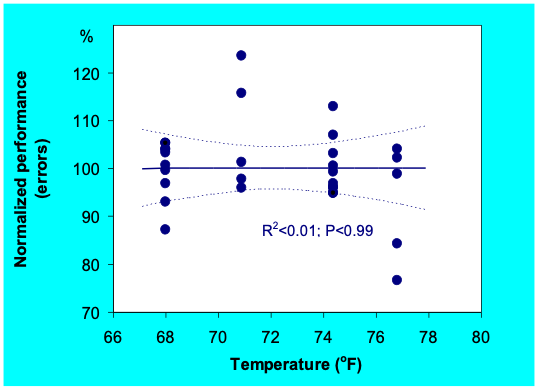Temperature and School Performance
Temperature and School Performance
Several studies conducted in the 1950’s and 1960’s found that students performed better in thermally conditioned classrooms than in classrooms without heating or cooling [1]. However, there have been few studies of the influence of temperature in thermally-conditioned classrooms on school work performance or learning. In the late 1960s, six groups, each with six students, were brought to a climate-controlled chamber at Kansas State University [1]. Each group of students performed simulated school work with chamber temperatures ranging from 62 to 92 oF. Error rates and speed of work were used as performance indicators. Two out of four performance measures, error rates and time required to complete assignments, were affected by temperature. The error rate was highest at 62 oF and lowest, about 20% lower, at 80 oF; however, students worked most slowly at 80 oF and fastest, about 10% faster, at 68 oF. Similar studies were also performed in the 1960’s by David Wyon and colleagues [2]. Some of these studies performed in climate chambers, and other studies in actual classrooms, found reading speed, reading comprehension, and multiplication performance of school children to be poorer with temperatures of 81 to 86 oF, relative to 68 oF. In one study [2], the decrements in reading speed and reading comprehension at 81 oF, compared to 68 oF, were as large as 30%.
While the previous studies focused primarily on the effects of avoiding temperatures of 80 oF or higher, the influence of more moderately elevated temperatures on student performance was investigated more recently via field studies conducted in classrooms [3]. Classroom temperatures were manipulated by turning cooling systems on and off, while keeping air circulation fans running so that noise levels were constant. All other factors were maintained constant to the degree possible, although, teachers opened windows “slightly more often when it was warm in the classroom”. Performance tasks representing eight aspects of schoolwork, from reading to mathematics, were embedded into the normal school work. The speed and accuracy of task performance was assessed. The average speed of eight simulated school work tasks decreased by approximately 1.1% per each 1 oF as temperatures increased from 68oF to 77 oF. The number of errors in school work was not significantly affected by temperature changes in this temperature range. Figure 2 provides more detailed results from this study [4].
 |
 |
Figure 2. Student performance versus temperature based on a study in Denmark [4].Performance was based on the speed (left figure) and accuracy (right figure) of completing various school work tasks. [Figure 2 reproduced with permission.]
2. Wyon, D.P., Studies of children under imposed noise and heat stress. Ergonomics, 1970. 15(5): p. 598-612. https://dx.doi.org/10.1080/00140137008931185.
3. Wargocki, P. and D.P. Wyon, The effect of moderately raised classroom temperatures and classroom ventilation rate on the performance of schoolwork by children. HVAC&R Research, 2007. 13(2): p. 193-220. https://dx.doi.org/10.1080/10789669.2007.10390951.